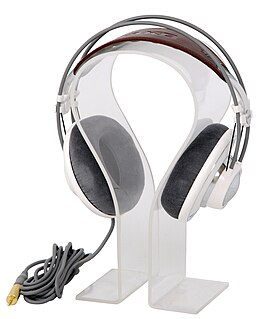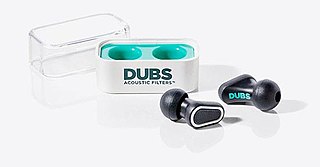
Binaural recording is a method of recording sound that uses two microphones, arranged with the intent to create a 3-D stereo sound sensation for the listener of actually being in the room with the performers or instruments. This effect is often created using a technique known as dummy head recording, wherein a mannequin head is fitted with a microphone in each ear. Binaural recording is intended for replay using headphones and will not translate properly over stereo speakers. This idea of a three-dimensional or "internal" form of sound has also translated into useful advancement of technology in many things such as stethoscopes creating "in-head" acoustics and IMAX movies being able to create a three-dimensional acoustic experience.

Headphones are a pair of small loudspeaker drivers worn on or around the head over a user's ears. They are electroacoustic transducers, which convert an electrical signal to a corresponding sound. Headphones let a single user listen to an audio source privately, in contrast to a loudspeaker, which emits sound into the open air for anyone nearby to hear. Headphones are also known as earspeakers, earphones or, colloquially, cans. Circumaural and supra-aural headphones use a band over the top of the head to hold the speakers in place. Another type, known as earbuds or earpieces consist of individual units that plug into the user's ear canal. A third type are bone conduction headphones, which typically wrap around the back of the head and rest in front of the ear canal, leaving the ear canal open. In the context of telecommunication, a headset is a combination of headphone and microphone.

A hearing aid is a device designed to improve hearing by making sound audible to a person with hearing loss. Hearing aids are classified as medical devices in most countries, and regulated by the respective regulations. Small audio amplifiers such as personal sound amplification products (PSAPs) or other plain sound reinforcing systems cannot be sold as "hearing aids".

The Turtle Beach Corporation is a gaming accessory manufacturer based in San Diego, California. The company has roots dating back to the 1970s where it developed sound cards, MIDI synthesizers, and various audio software packages and network audio devices. The company began making gaming headsets in 2005.

Headsets connect over a telephone or to a computer, allowing the user to speak and listen while keeping both hands free. They are commonly used in customer service and technical support centers, where employees can converse with customers while typing information into a computer. Also common among computer gamers are headsets, which will let them talk with each other and hear others, as well as use their keyboards and mice to play the game.

AirPods are wireless Bluetooth earbuds designed by Apple Inc. They were first announced on September 7, 2016, alongside the iPhone 7. Within two years, they became Apple's most popular accessory. The most recent model, AirPods, are a replacement to the 1st and 2nd Generation models, although the 2nd Generation is still sold on Apple's website. These models are Apple's entry-level wireless headphones, sold alongside the AirPods Pro and AirPods Max.

Apple Inc. has produced and sold headphones since 2001, available for standalone purchase and bundled with iPhone and iPod products. Apple's current product line consists of EarPods, AirPods and AirPods Pro, and AirPods Max.

SMS Audio is an American consumer electronics company that primarily manufactures and markets headphones. The company was founded by 50 Cent in 2011 and acquired Kono Audio that same year.

Hearables or smart headphones or earbuds are electronic in-ear devices designed for multiple purposes. The category is split between hearables for hearing health, and hearables for other applications.

Jaybird is a Utah-based consumer electronics company owned by Logitech. The company designs and manufactures headphones and wearable activity trackers. The company is mainly known for its line of wireless Bluetooth sports headsets. Jaybird was founded in 2006 by Australian entrepreneur Judd Armstrong.

Bragi is a German technology company headquartered in Munich, Germany, that designs, develops and sells wireless smart earphones; the Bragi OS, the operating system for next-generation computing platforms; and the Bragi App for smartphones.

Doppler Labs was a San Francisco-based audio technology company, founded in 2013. The company designed and manufactured in-ear computing technology, including earplugs and wireless smart earbuds.

Noah Kraft is an American entrepreneur, and the co-founder and former CEO of Doppler Labs, an audio-technology company best known for its Here One Wireless Smart Earbuds. Despite a promising start, their flagship product suffered from various issues and sold many fewer units than expected upon release. After an unsuccessful attempt to raise additional capital, Doppler Labs ceased operations in December 2017.

DUBS Acoustic Filters are ear plugs designed by Doppler Labs and were released in 2014. They use a proprietary 17-piece physical acoustic filter system which reduces sound pressure at different frequencies whilst maintaining acoustical fidelity.

Nura is a consumer electronics company based in Melbourne, Australia, that designs and manufactures headphones with personalized sound technology. Nura's proprietary technology automatically measures the user's hearing sensitivities to different frequencies by monitoring sounds generated from the inner ear. This hearing measurement process takes 1–2 minutes. The headphones then adapt their frequency response to the user's hearing, allowing them to hear more detail when listening to music.
In sound technology, personal sound refers to a range of software solutions that customize an audio device's sound output to match the listener's unique hearing sensitivities. The technologies aim to optimize the sound quality in the audio device to ensure they best fit the hearing perception of each unique listener.

AirPods Pro are wireless Bluetooth in-ear headphones designed by Apple, initially released on October 30, 2019. They are Apple's mid-range wireless headphones, sold alongside the base-level AirPods and highest-end AirPods Max.

Origin North Ltd., formerly RHA Technologies Ltd., is a British independently owned audio company specialising in the design and production of in-ear headphones.


















